Did you close your pool for winter? Even if you left it open and indulged in a few laps, Summer is coming, so it’s time to get the water ready for a whole lot of splashing, especially if you intend to have fun-filled barbeques and Christmas guests.
Above ground pools and in-ground pools have similar maintenance patterns, so reviving them for summer follows the same necessary steps. If you haven’t installed your surprisingly cheap swimming pool yet, it’s not too late. Get in touch with us here at Affordable Pools, and we can discuss the logistics of installation. But if you need to re-open your existing pool, here are some suggestions.
Opening the pool is more work than you’d think, so enlist the help of a few friends. You can always pay them in barbequed treats, and it’s certainly a good excuse for a party. Most people open their pools around the same time, but you should plan to open yours a few weeks early.
When you open your pool early, you might get pool gear at discounted ‘new season’ prices. It will also be easier for you because the weather won’t be uncomfortably hot yet. Concerning cleanliness, the hotter it is, the more algae grows, so it’s useful to open the pool before more algae sprouts beneath the pool cover.
Go to the pool store and buy all the supplies you need. You will need a pool opening kit, which usually contains pool chemicals like chlorine, alkalinity products, and chlorine stabilisers. For an above ground pool do be careful not to go overboard on chemicals. Regarding tools, you will need a telescoping pole, a pool brush, a skimmer head, a vacuum hose, and a vacuum head.
Also Read This: Our DIY Solar Kits in focus
Test strips are essential as well. Pools respond in different ways, depending on water content, duration of the closure, contaminant levels, and atmospheric conditions. The colour of the water could range from clear to mossy green. You’ll need to clean the water, then do basic maintenance, cleaning the floor and sides with a pool brush and skimmer basket.
Start by removing the pool cover, then turn on the pump and filter, and keep them running until the pool water reaches its usual clean colour. Once the water’s natural tone is restored, put the filter back into a cycle of 10 to 12 hours per day. The colour of the pool isn’t an indicator of its health. To find that out, you need to run a test.
For your test results to be accurate, you need to take a proper sample. You shouldn’t dip the test strip into the pool or scoop a cup from anywhere in the pool. Instead, stretch your hand over the pool, away from the return line. Invert the cup so that it’s upside down, then lower your hand into the pool until the water reaches your elbow.
Turn the cup back upright and raise it out of the pool, full of water. Dip your test strips in the cup to check the levels of chlorine or salt, depending on what pool sanitizer you use. You will also check for pH, alkalinity, calcium, chlorine hardness, or cyanuric acid.
If possible, take the water sample to the pool store instead of checking it yourself. Since this will be the first test after opening the pool, having it done professionally will give you more detailed results. Make sure to mention the type of pool you have as above ground pools have different requirements to concrete pools, and so on. Once you have your results, you’ll know what chemicals to add or reduce.
Your pool should be at around 7.2 pH. You can also put in some algaecide to get rid of anaerobic plant growth.Your pool is now ready to use. Clean your pool cover, store it, and dive in.
For more information on all kinds of swimming pools, call us today on (02) 8625 3656.

